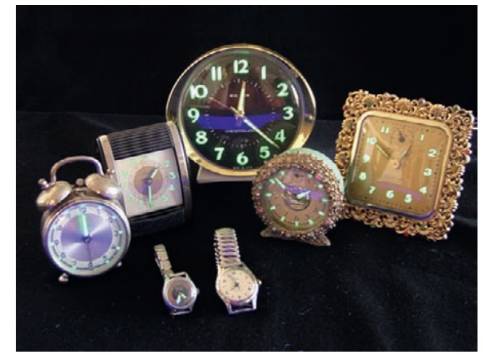
Concept explainers
Exercise19.3Watches with numerals that glow in the dark” formerly were made by including radioactive radium in the paint used to letter the watch faces. Assume that to make the numeral 3 on a given watch, a sample of paint containing

Watches and clocks with radium dials.
Trending nowThis is a popular solution!

Chapter 19 Solutions
Introductory Chemistry: A Foundation
Additional Science Textbook Solutions
Chemistry: Structure and Properties (2nd Edition)
Chemistry (7th Edition)
Chemistry: Atoms First
Organic Chemistry (9th Edition)
Principles of Chemistry: A Molecular Approach (3rd Edition)
Organic Chemistry As a Second Language: Second Semester Topics
- QUESTION 15 Alchemy is frequently associated with the transmutation of lead into gold. This transformation is possible by the combination of which two decay processes occuring in sequence? If you believe the same process occurs twice, only select a single answer (e only choose only a if you believe it is two alpha decays) O Og Caarrow_forwardactions: Types and X Week 18 Concept Check Ervin !! pOLsdSUFh6n9jHY2beNbp9GDg0fG2LTumwbTCF2paecp714h_ihw/viewform?hr_su In the equation below X must be a ZY _ XY +_Z, -> Anion Cation Noble Gas Positron In the equation MgO + Fe - FeO + Mg, Fe replaces what element?arrow_forwardThere is no x-0.50 option What am I supposed to do??arrow_forward
- Question 9 How many copper atoms are in a pipe with a mass of 9.3 grams? 8.8 Question 10 A typical "lcad" pencil is actually made from carbon. If the carbon in the pcr weighs 1.50 grams, the pencil has latoms] atoms of carbon. 7.5arrow_forwardQuestion 30 A certain radioactive isotope has a half life of 17.9 years. What percent of a sample remains after 87.5 years? Report your answer to one decimal place. Do not input a unit. Click Submit to complete this assessmentarrow_forwardWith the image attached please do the calculations/calculate what is highlighted in yellow please Please also calculate - percent % error in molar mass - percent % error in pKa Please please please answer as fast as possiblearrow_forward
- Exercise 17.76 A 56 mg sample of a radioactive nuclide is administered to a patient to obtain an image of her thyroid. Part A If the nuclide has a half-life of 12 hours, how much of the nuclide remains in the patient after 5.0 days? Express your answer using two significant figures. mg mg = Submit Request Answer Provide Feedback MacBook Airarrow_forwardDuei Monday Y31 Name: _Adriona Lab Partner(s) Stacy Date: _1/24/22 Report Pages DATA Mass of the empty evaporating dish 48.06 니9.23 b Mass of evaporating dish plus zinc metal 50.474 C Mass of evaporating dish plus zinc-chloride compound CALCULATIONS Mass of zinc present in the compound 49.23-48.06 Moles of zinc present in the compound -0018g/mol 1.17g:(1 mole 65.38g =0.018g/mol %3D Molor Mass of chlorine present in the compound 1.244 50.474-49.23 = 1. 24L4 Moles of chlorine present in the compound 0.035 1.244: Imole 35.45 Find the empirical formula of the compound as determined by your experimental data. 6.035 : 1.944 0.018 Empirical Formula: \,944 CHEM&121 Lab 2arrow_forwardQUESTION 20 Iron-59 is a radioactive nuclide (t1/2 = 46 d) used in anemia diagnosis. If the initial count rate of an Fe sample is 560 counts/min., how long will it take (days) for the count to drop to 400 counts/min ? %3D Enter your answer in decimal format with one decimal place (value ± 296).arrow_forward
 Introductory Chemistry: A FoundationChemistryISBN:9781337399425Author:Steven S. Zumdahl, Donald J. DeCostePublisher:Cengage Learning
Introductory Chemistry: A FoundationChemistryISBN:9781337399425Author:Steven S. Zumdahl, Donald J. DeCostePublisher:Cengage Learning General Chemistry - Standalone book (MindTap Cour...ChemistryISBN:9781305580343Author:Steven D. Gammon, Ebbing, Darrell Ebbing, Steven D., Darrell; Gammon, Darrell Ebbing; Steven D. Gammon, Darrell D.; Gammon, Ebbing; Steven D. Gammon; DarrellPublisher:Cengage LearningChemistry: Matter and ChangeChemistryISBN:9780078746376Author:Dinah Zike, Laurel Dingrando, Nicholas Hainen, Cheryl WistromPublisher:Glencoe/McGraw-Hill School Pub Co
General Chemistry - Standalone book (MindTap Cour...ChemistryISBN:9781305580343Author:Steven D. Gammon, Ebbing, Darrell Ebbing, Steven D., Darrell; Gammon, Darrell Ebbing; Steven D. Gammon, Darrell D.; Gammon, Ebbing; Steven D. Gammon; DarrellPublisher:Cengage LearningChemistry: Matter and ChangeChemistryISBN:9780078746376Author:Dinah Zike, Laurel Dingrando, Nicholas Hainen, Cheryl WistromPublisher:Glencoe/McGraw-Hill School Pub Co


